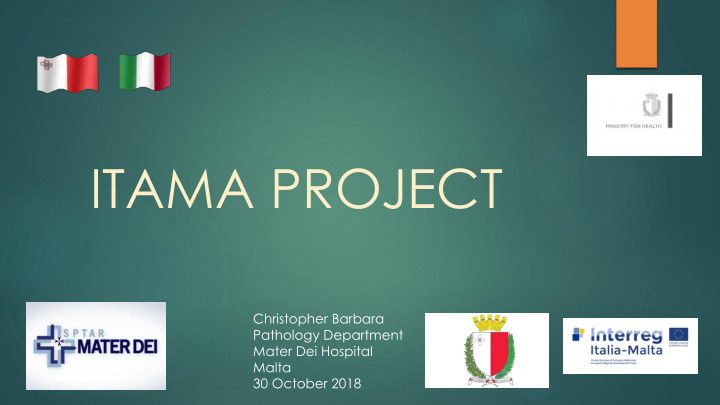



ITAMA PROJECT Christopher Barbara Pathology Department Mater Dei Hospital Malta 30 October 2018
Bellizzi, M. (1992).The Maltese Food Revolution • : An analysis of the eating habits in Malta. wheat products (bread and pasta), and rice are • the major source of energy in the Maltese diet contributing a third to the total energy The staple cereal in Malta is wheat, mainly as bread • (78%) and then, mainly as local white bread (99%). Pasta contributes 11% to the total purchase of • cereal products .
Regional distribution of Coeliac Disease in the Maltese Islands* 9 29 40 9 20 24 9 5 14 7 3 1 3 18 8 44 2 17 2 7 17 3 5 10 3 15 7 30 5 5 25 26 5 31 23 9 12 17 4 15 5 18 35 6 3 17 4 21 7 16 25 * Crude 5 20 5 prevalence 15 30 8 4 9 individuals 2 7 8 8 20 receiving benefits 10 for GFD
Clinical Case recognition in the Maltese Islands • Prevalence of CD based on clinical diagnosis & GFD: 1.9 / 1,000 (1 in 526 gen. Pop n ) Older age at diagnosis of paediatric cases C. Vella, V Grech Ind. J Peds 2004 • cf Analogous population based study (clincal presentation / GFD) from Sicily - prevalence 1.65/1,000; adjusted actual standardized rate 3 /1,000 . Magazzú G, et al. Acta Paediatr. 1994;83(10):1065-9. • cf worldwide average 1:3345, on clinical, 1:266 on screening data † † Fasano & Catassi, Gastroenterology 2001; 120:636-651.
Origin of the Maltese Population The islands were inhabited from around 5000 B.C. till 800 A.D. • Became uninhabited for a short period between the year 800-1000 A.D. • Slow immigration from Sicily starting from 1000 A.D with a high • immigration flow from Sicily and South Italy from 1530 A.D. onwards.
ACTION PLAN – TWO STAGES Identification of potential cases. Information leaflet with consent and validated questionnaire Point of care tests - human resources Confirmation of cases. Criteria for further testing Investigation and free access to treatment
DATA COLLECTION STAGE 1 - Large number of children – estimated 20,000 Testing done by appropriately trained personnel. Information Booklet + Questionnaire + Consent form Point Of Care Test
OUTCOMES Data generation Application of the research to build the computer programme Cost-effectiveness of a screening programme Inter-regional co-operation and connections Possible application of a similar strategy for other autoimmune diseases
Thank You For Your Attention
Coeliac Disease research carried out in Malta.
Recommend
More recommend